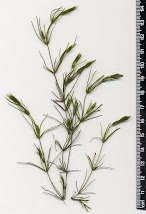As plant life evolved, several major breakthroughs allowed them to greatly expand their footprint across the globe. These breakthroughs were major macroevolutionary shifts brought about by a series of small microevolutionary adaptations. The essential characteristics of Plants are each associated with one or more of these major breakthroughs. Such events are described in more detail in Plant Life: a Brief History, I present here a brief synopsis of those major events:
 |
| The earliest known fossil cyanobacteria formed layered colonies that slowly built pillar-like formations called stromatolites, like these from present-day Australia. Photo by Paul Harrison, CC BY-SA 3.0 |
.jpg) |
| Chlamydomonas, a single- celled alga CC by-SA 2.0 |
3. Origin of eukaryotic algae - Primitive animal-like cells, already equipped with mitochondria, captured cyanobacteria through endosymbiosis, which were "domesticated" to become chloroplasts. (Plants and animals and kleptoplasts - oh my!) This occurred a number of times, resulting in multiple unrelated organisms called algae, which at first floated as part of the phytoplankton of the seas. Sexual reproduction via cells specialized as sperm and egg evolved in these early algae, along with mitosis and meiosis.
 |
| Freshwater charophytes are related to land plants |
4. Origin of multicellular plants - With cells remaining attached to one another, and usually also anchored to rocks and other substrates, multicellular algae were able to branch into extensive light-gathering antenna systems, resulting in the various kinds of seaweeds and freshwater plants like charophytes.
 |
| Mosses were among the earliest land plants, and continue to thrive in moist habitats. Modern Sphagnum mosses pictured here form vast peat bogs, particularly in boreal regions. |
5. Invasion of the land - Green algae adapted already to freshwater habitats, colonized the land, becoming the ancestors of both bryophytes (mosses, liverworts, and hornworts) and tracheophytes (vascular plants like ferns, gymnosperms, angiosperms). Early land plants survived by developing water-retaining outer layers and internal systems for storing and transporting water. While such plants remained close to bodies of water at first, they created the vegetation that supported the first animal life to leave the water. The hydrostatic, or turgor, pressure within terrestrial plant cells maintains cell and tissue rigidity and drives cell expansion. It also drives the transport of food-laden fluid in the phloem tissue water and, in combination with evaporation and transpiration, helps drive the movement of water from the roots to the leafy plant tops, even in trees 100 meters tall. (How does water get to the top of a redwood tree?) Turgor pressure is also the basis of plant movements, such as the closing of of leaf traps in the Venus fly trap. (How plants do everything without moving a muscle?)
 |
| Ferns produce wind-dispersed spores that sprout into gametophytes. |
 |
| Ovules contain the stages of reproduction, from spore, to gametophyte, to embryo surrounded by food (seed). In this cycad, ovules are borne on modified leaf-like structures. |
6. Evolution of the seed - The seed, called in its early development an ovule, is both a chamber for internal sexual reproduction and a vehicle for the dispersal of the embryo once it matures. Eggs are produced by highly reduced gametophyte plants within the ovules, while sperm cells are produced by even smaller gametophyte plants within specialized spores called pollen grains, which are brought to the ovule by wind or insects. This liberates plants from the need for water-transmission of sperm to egg, enabling them to live and reproduce in drier habitats, the same way as internal fertilization and laying of desiccation-resistant eggs allowed reptiles to spread through dry terrestrial habitats. The earliest seed plants, took the form of seed ferns, in which pollen-producing sporangia (pollen sacs) and ovules were borne directly on large, fern-like leaves. In more advanced gymnosperms, pollen and ovule forming leaves became distinct from the vegetative leaves and took different forms, most often scale-like structures grouped into strobili (cones if rigid, catkins if soft and flexible). Among living gymnosperms, only some cycads have ovule-bearing structures that still resemble leaves.
 |
| Magnolia flowers have numerous distinct carpels (uppermost), numerous stamens, all subtended by a number of tepals (petals/sepals) |
 |
| Grasses dominate extensive areas with alternating wet and dry seasons. Photo by V. S. Dustin CC BY SA-3.0 |
8. Re-evolution of the herbaceous habit - While ferns and other non-seed-bearing plants were herbaceous, early seed plants and all gymnosperms are woody, as required for the slow development and maturation of their seeds. Angiosperms further shortened the reproductive cycle, so as to make quick-growing, winter-dormant herbs possible again. The most significant group of angiosperm herbs are the monocots, with grasses being the most widespread and ecologically significant herbs on the planet. (How the grass leaf got its stripes) (The grasses that would be trees) Grasses support vast food webs on seasonally dry savannas, and their seeds provide the major source of sustenance for humans around the globe.
9. Evolution of varied secondary plant compounds - All through the evolution of plants, which are both nutritious and immobile, animals evolved to feed upon them. While some plants, like many algae and grasses, could multiply fast enough to overcome such predation, many other plants have evolved deterrents, including hard fibers and various forms of spines, thorns, etc., but most importantly toxic or repellant chemicals. Plant chemicals that deter animal herbivores have become numerous and diverse as different species of animals developed immunity to some but not all. By nature, secondary plant compounds are physiologically active and while poisonous in some circumstances, often have valuable medicinal effects. As such, they have been vital to the survival of the human species. (Medicinal plants in our own backyard)
No comments:
Post a Comment
Note: Only a member of this blog may post a comment.